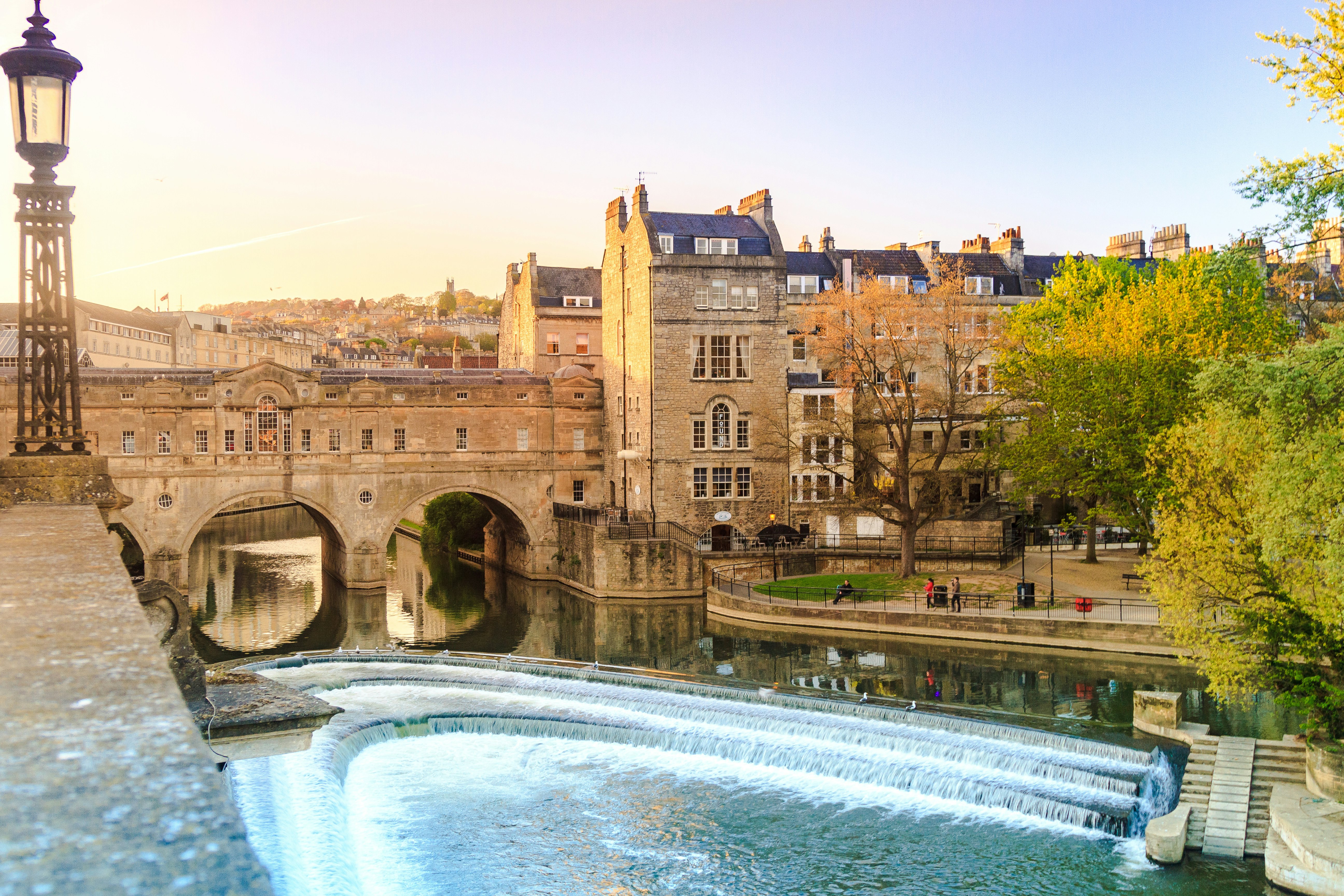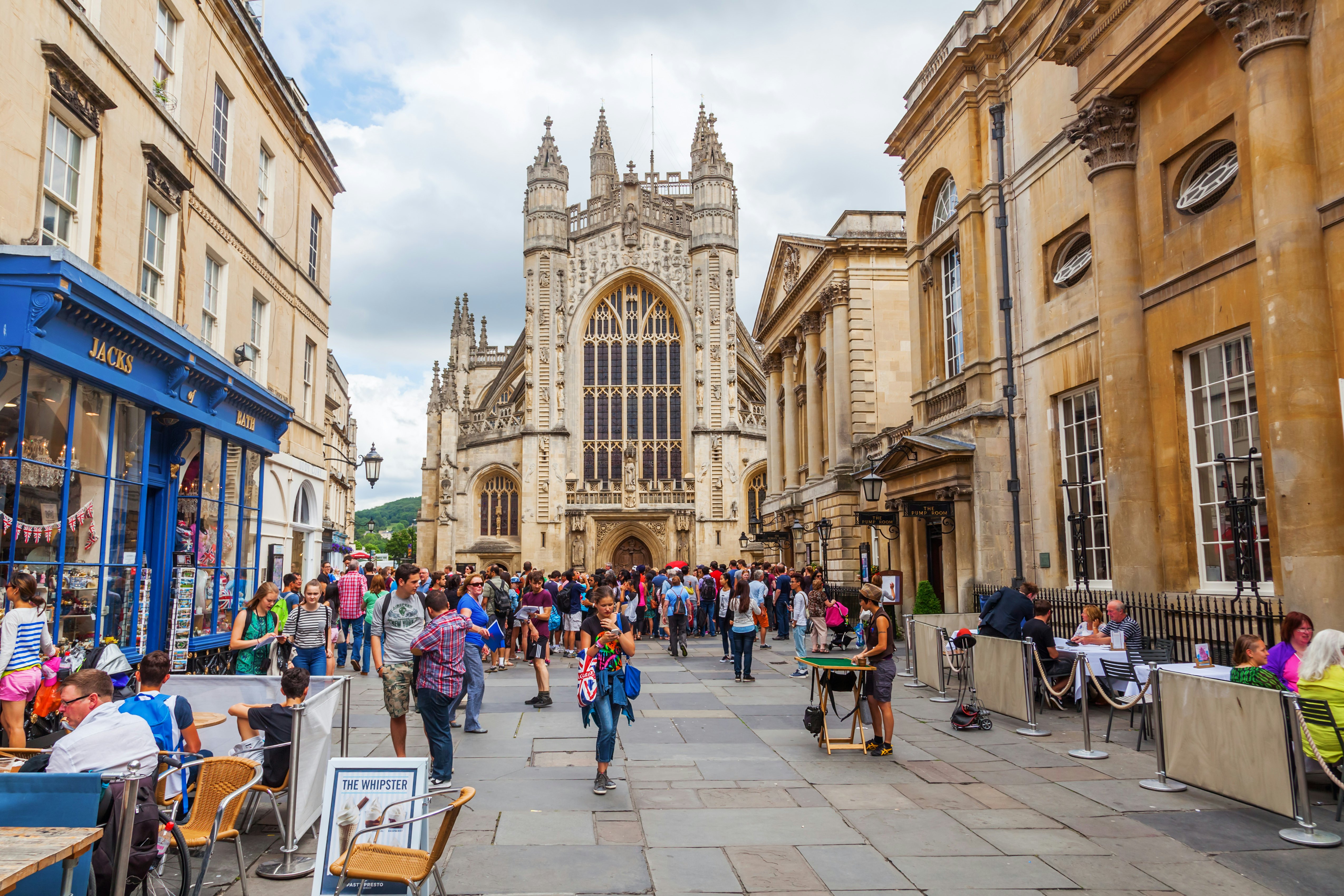
Discover Bath’s most beautiful architecture, from the Roman Empire to Regency England

Jul 11, 2022 • 6 min read

Wander the spectacular architecture of Bath, England © Matt Cardy / Getty Images
Founded by the Romans and polished into honey-colored grandeur by the Georgians, the ancient spa city of Bath is renowned for its architecture. Whether you’re in search of Bridgerton backdrops or ancient Roman marvels, Bath’s historic buildings make this one of the prettiest cities in southwest England.
With a staggering 5000 or so listed buildings and UNESCO World Heritage status, Bath’s history comes alive at every turn. And that story takes us right back to the 1st century CE, when the ancient Romans founded the town of Aquae Sulis around the natural hot springs here.
In the 18th century, those same hot springs enticed the Georgian aristocracy as the rediscovered health fad of "taking the waters" boomed among high society. In just 100 years, Bath was transformed from a small medieval city into a fashionable metropolis some ten times its former size, with almost all buildings uniformly constructed from local, gold-beige limestone.
It’s thanks to that Georgian town planning that Bath enjoys the fame it does today. The spa city’s 18th-century streets have provided the perfect backdrop for both big and small screen period pieces, most recently starring as Georgian “London” in the hit Netflix show Bridgerton.
Spring is a particularly lovely time to visit, when cherry blossoms and purple wisteria bloom against the fawn tones of the Bath stone. But whenever you visit, Bath’s living history is a delight to explore.
Soak up the city's history at the Roman Baths
Bath’s Roman origins are an integral part of its architectural history. Unlike the more typical Roman garrison towns, Aquae Sulis was a center for relaxation and healing.
Today the Roman Baths in the city center feature some of the best-preserved ancient Roman architecture in the world. Explore the 2000-year-old pavements, plunge pools, and temples of this religious spa, constructed around 70 CE. Follow the excellent audio guide to learn more.
The centerpiece is the large rectangular bathing pool. Surrounded by a picturesque colonnaded walkway, the pool is still fed by 1,170,000 liters (309,000 gallons) of 46°C (115°F) spring water every day.

Enjoy a movie-star backdrop at Royal Crescent
Overlooking the Royal Victoria Park, the Royal Crescent is one of the most iconic sights in Bath and a regal example of 18th-century Palladian architecture. This curved line of 30 terraced houses was designed by John Wood the Younger, a local architect who – along with his father John Wood the Elder – was instrumental in designing the way Georgian Bath looked.
This beautiful crescent is also one of Bath’s most filmed locations, from Vanity Fair (1967) to The Duchess (2007) and Bridgerton (2020).
Don’t miss No. 1 Royal Crescent to discover interior architecture and design typical of the Georgian period. Now open as a public museum, the rooms have been decorated and furnished exactly as they would have been by wealthy families in the late 18th century.
Discover Bath’s Georgian Palladianism at the Circus
John Wood the Elder’s lofty ambition was to restore Bath to its former Roman glory. He designed several of the city’s most beautiful streets and buildings, chief among them the Circus. Originally called King’s Circus, this ring of terraced townhouses is made up of three curved segments, forming a circle with three entrances.
Combining his passions for ancient history and Palladianism, Wood the Elder designed the Circus with the same diameter as Stonehenge and took his inspiration from the Colosseum in Rome. It’s believed that both Woods had connections with the Freemasons: look closely at the frieze above the columns on the Circus’ terraced houses and you’ll spot many masonic symbols, among other emblems.

Browse the shops on Pulteney Bridge
Built in 1774, Pulteney Bridge – which overlooks an attractive horseshoe-shaped weir in the River Avon – is another example of the Palladian style so popular in Bath. It also happens to be one of only a handful of bridges in the world built with shops across its full span on both sides.
Head to the riverside opposite The Empire on Grand Parade for the best view of the bridge and weir. Once you’ve crossed the bridge, continue east along the grand Great Pulteney Street, which is lined on either side by Georgian properties.
Take a turn around the Assembly Rooms
While many of Bath’s architectural marvels can only be enjoyed from the outside, visitors can enter the Assembly Rooms for an intriguing glimpse of high society life in Georgian England.
Home to a Ball Room, Tea Room, and Card Room, the Assembly Rooms were the epicenter of the 18th-century social scene. Today the elegant rooms – complete with typical Georgian decor and original crystal chandeliers – are still used for functions, but they can be toured when they haven’t been hired out.

Climb Bath Abbey Tower for a dazzling cityscape
Bath Abbey traces its origins right back to the 7th century. It was rebuilt in 1499 in the Perpendicular Gothic style (although it wasn’t completed until 1620) and is one of the few medieval buildings that can be seen in Bath’s city center following the Regency reinvention of the 18th century.
Look up to admire the Abbey’s fan-vaulted ceilings, created in the 1500s by the king’s master masons. Take the Tower Tour for one of the best views of Bath’s city center, or enjoy a fabulous view of the Abbey tower from the rooftop pool at the popular Thermae Bath Spa.
Call on Bridgerton’s Lady Danbury at the Holburne Museum
Those visiting Bath in search of Bridgerton filming locations won’t want to miss a trip to the Holburne Museum. The building’s grand exterior, with its pillars and covered loggia, starred as Lady Danbury’s residence in the Netflix show.
Once the Sydney Hotel, a fashionable Georgian social venue, this impressive Grade I listed building has been home to Bath’s first public art gallery since 1916. Don’t miss a visit to the Sydney Gardens behind the hotel: dating from 1795, these are one of the only surviving Georgian pleasure gardens in England.
Eat a Bath Bun at Sally Lunn’s
One of the oldest houses in Bath, dating from at least 1482, Sally Lunn’s is something of an institution. While most of “Old Bath” was swept away during the 18th-century, this historic little shop is a unique reminder of medieval Bath.
Sally Lunn’s rose to fame as the home of the original Bath Bun: a light, cake-like bun similar to brioche, thought to have been invented by the shop’s namesake in 1680. Today it’s a cozy tearoom set over several floors, still serving Bath Buns cooked to Sally Lunn’s original 17th-century recipe.
Learn More at the Museum of Bath Architecture
Visitors with a keen interest in Bath’s architectural history can gain a detailed overview in this charming museum. The Museum of Bath Architecture is housed within the Countess of Huntingdon’s Chapel, a significant building its in own right and one of the only examples of post-medieval Gothic in Bath. The chapel was built in 1765 for Selina Hastings, the Countess of Huntingdon, and was one of many she built in England as part of her campaign to spread Methodism throughout the country.















